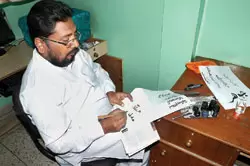An Urdu newspaper sells at 75 paise per copy and still employs calligraphers
01-August-2011
Vol 2 | Issue 30
Musalman, being published from Chennai, is one of the oldest Urdu language newspapers in India. The paper was started by Azmatullah way back in 1927 to give a voice to the Indian Muslims. The world may have changed a lot since then as well as the methods of printing and publishing, but not for the publishers of the old Urdu paper. At the Musalman, calligraphers can still be seen eking out their living by writing out the entire newspaper!
Arifullah, the editor of the paper and the grandson of Azmatullah, resists the use of modern technology because he is positive that “the reader of our newspaper prefers the handwritten font”. But that is not the only reason. “If we switch over to modern technology, we will be completely dependent on power. Now, even if there is no power we have no problem as editors and the katibs (calligraphers) can prepare the paper in candlelight,” smiles Arifullah. You look at him in disbelief but his confidence makes you ponder over this reasoning for a moment.
 |
|
Affordably priced: By keeping the production cost low, Musalman is able to keep its price at an unbelievable 75 paise! (Photos: Media Watch)
|
“Thirdly,” he continues, “a huge investment is required for switching over to computers and all. If we invest then the price of the newspaper will go up and the Urdu reader won’t be able to afford that extra cost.”
However, many present day Urdu editors would find it hard to go by Arifullah’s logic and arguments. Atiq Siddiqui, the editor of the fortnightly Al-Yaum says, “It is both a necessity and a compulsion to use modern technology and one cannot ignore it.”
He adds, “There were two very popular Urdu newspapers in Uttar Pradesh namely Al-Watan and Wahdat in 1912 and my grandfather Maulana Mazharudin was the editor of these two newspapers. At that time these papers were published on handset press machines that was the latest printing technology then. We have to move on with the times.”
Reminiscing about the old days, Saud Alam, a Delhi based calligrapher says, “I used to have 12 qalam (pens made of reed) of different sizes and it was a wonderful experience to write with each one of them. No doubt handwritten fonts were beautiful but you have to move ahead with the times.” Like Alam, many katibs have come to the terms with the fact that modern technology is no longer avoidable and they, too, will have to move on.
 |
|
Calligraphers write the entire content of Musalman
|
But Arifullah argues, “Urdu Newspapers get little revenue from advertisements and this is another reason why we cannot shift to computers.” There are four katibs who write the four broadsheet pages and if there is any mistake then they have to rewrite the entire page. Arifullah says “The staff work on part time basis. The work in the office starts at nine in the morning and the editors and calligrapher prepare the four pages in four hours and around one in the afternoon it goes to the press for printing.” Reporters deliver news by phone or fax.
The Musalman has reporters in New Delhi, Kolkata, Hyderabad, and other Indian cities. The front page is for national and international news; the second and third for local news; and the fourth for sports. They leave a square of space on the bottom right corner of the front page blank, in case of breaking news. There are few advertisements.
The official circulation figure of this evening newspaper is stands at 23000 copies per day and the selling price of 75 paisa seems rather infeasible in this age and time. But the editor is clear about not increasing the price as he wants to keep the newspaper affordable for the clientèle, many of whom are old timers almost addicted to the Musalman. And he is determined to carry on the family tradition as long as he can, and calligraphers remain available to work for a pittance.
It is true that unlike many Urdu newspapers across the country that could not survive due to high investments and low advertisement revenue, Musalman is just 16 years away from registering a century of existence – a feat that has to be acknowledged and admired.
Published by special arrangement with Media Watch
















